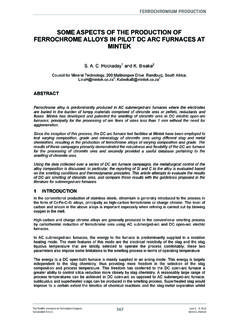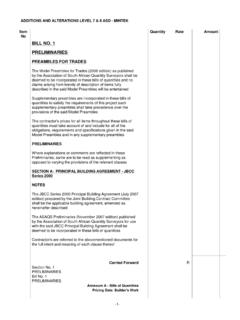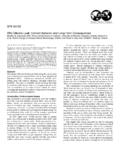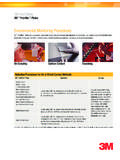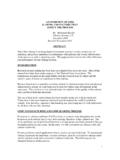Transcription of The hydration of MgO-based refractory materials
1 1 The hydration of MgO-based refractory materialsAndrieGarbers-Craig4 June 2009 Department materials Science & Metallurgical Engineering2 OUTLINE Background Literature Projects completed at UP Work in progress AcknowledgementsDepartment materials Science & Metallurgical Engineering3 BACKGROUND MgO-based refractory materials are widely used steel, titania, ferroalloy, copper, platinum, foundry, glass, cement industries MgO-based refractory materials can potentially hydrate During transport, storage, installation, commissioning and operation, but also when water is mixed with refractory castables Costs associated with replacing a MgO-based liningamount to tens of millions of rands, depending on the size of the smelter Risk of hydration of MgO-based materials is minimised by Storing in closed rooms at 10-30 C with good ventilation Avoiding condensation under shrink wrapping Installing bricks as close to heat-up as possibleDepartment materials Science & Metallurgical Engineering4 BACKGROUND (cont.)
2 MgO-based refractory materials hydrate at temperatures below ~270 C to form brucite:MgO+ H2O Mg(OH)2 Bruciteformation increases pH, allowing CO2to dissolve in water, generating H2CO3, and forming MgCO3:MgO+ H2O + CO2 MgO+ H2CO3 MgCO3 Also reports of white film of hydro-magnesite:Mg5(CO3)4(OH) materials Science & Metallurgical EngineeringBrucitecrystals, 1:3000 (RHI)5 BACKGROUND (cont.) Why is MgOhydration a major concern in refractory formulations? 3-fold volumetric expansion due to differences in densities between MgOand Mg(OH)2 Generates stress leading to severe mechanical damages, and premature degradation Cracking increases available surface areas and further promotes the hydration process Microstructure of the brick is not restored during re-firing Loss of bond between aggregate and matrix Increased porosityDepartment materials Science & Metallurgical EngineeringSalamao& Pandolfelli, 20086 BACKGROUND (cont.) Partially hydrated MgOparticles in castables Pre-cast shapes become distorted and brittle Consequences on drying schedule Decomposition of Mg(OH)2layer generate porosity, high surface area and reduced mechanical strength hydration protection MgSO4 (kieserite), tar impregnation Research on inhibiting hydration through additives, surface modification of grains The Big Question-When can a MgO-based lining which had some hydration damage be used & when must it be replaced?
3 Department materials Science & Metallurgical EngineeringRHI7 LITERATURE: Factors affecting hydration resistance of MgO-based refractories Quality of MgO Microstructure and purity (type and amount of impurities) Relative density, Porosity & Pore size distribution Grain size, crystallite size & surface area Processing parameters Calcinationand sintering temperatures Holding time Water vapourpressure hydration temperature Cooling of calcinedgrains must be under lowest possible RHDepartment materials Science & Metallurgical Engineering8 LITERATURE: hydration of magnesia refractorieswith different firing parametersDepartment materials Science & Metallurgical Engineering(Shaw, 1972) (1): Stored at 60 C(2): Stored at 40 C(3): Stored at 20 C9 LITERATURE: hydration mechanism of polycrystalline magnesia(Kitamura, Onizuka& Tanaka (1995))Department materials Science & Metallurgical Engineering(Kitamura et al., 1995; Salom oet al., 2007) Disintegration into smaller grainsPolycrystalDisintegration into monocrystalsDustingInduction period10 LITERATURE: Mechanisms of hydration (Lauzon, Rigby, Oprea, Troczynski, Oprea(2003))Department materials Science & Metallurgical EngineeringHydration under room conditionsHydration in autoclave under steam at kPaN: MgO, C/S =.
4 S: MgO, C/S = : 95% MgO, C/S = Most common methods whereby hydration is evaluated: Measurement of LOI XRD TG / DTA Infrared Spectroscopy Young s modulus of elasticity (MOE) hydration tests are performed in Steam ovens / hydration chambers AutoclavesDepartment materials Science & Metallurgical EngineeringRHI12 FIRST FACT FINDING PROJECT:(D Swanepoel, 2008) hydration of various MgO-based raw materials : Sintered MgO Fused grain MgO Fused grain MgO-chrome hydration of refractorybricks: MgO-based bricks MgO-chrome bricks Using a steam oven at 80 C over extended periods of time Analyse samples: Calculation of % hydration vs. time XRD TG / DTAD epartment materials Science & Metallurgical Engineering13 hydration of MgO-based raw materials :(D Swanepoel, 2008)Department materials Science & Metallurgical EngineeringR3= sintered MgO, C/S~ sintered MgO, C/S~1, high impurity contentFused MgO, C/S~2A1= Mag-chrome, C/S~ Mag-chrome, C/S~ of MgO-based bricks: (D Swanepoel, 2008)Department materials Science & Metallurgical EngineeringB1: MgO-based , C/S~ : MgO-based , C/S~ : Mag-chrome, C/S~ : Mag-chrome, C/S~ : Mag-chrome, C/S~ : Mag-chrome, C/S~ IN PROGRESS:(KaraboSetlhare, 2009)Relationship between the degree of hydration of MgO-based and kieserite-dipped MgO-based bricks and: CCS (cold crushing strength) Cold-MOR and Hot-MOR (modulus of rupture)Department materials Science & Metallurgical EngineeringRHI16 WORK IN PROGRESS.
5 Time before hydration test Role of adsorbed H2O film in hydration reaction Find a mobile, user friendly hydration testing device, whereby the extent of hydration of MgO-based refractory linings can be evaluated in a non-destructive manner MEng(Metallurgy), Starting Aug. 2009 Department materials Science & Metallurgical Engineering17 Acknowledgements Students & UP: DewaldSwanepoel KaraboSetlhare Department of Civil Engineering Support from industry: Hatch SA & Lonmin Exxaro RHI VereenigingRefractories Vesuvius SADepartment materials Science & Metallurgical Engineering


